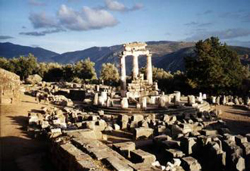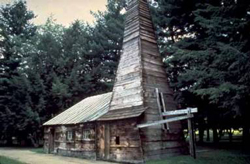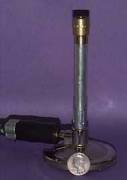History
Natural gas is nothing new. In fact, most of the natural gas that is brought out from under the ground is millions and millions of years old. However, it was not until recently that methods for obtaining this gas, bringing it to the surface, and putting it to use were developed.
Before there was an understanding of what natural gas was, it posed a mystery to man. Sometimes, lightning strikes would ignite natural gas that was escaping from under the earth’s crust. This would create a fire coming from the earth, burning the natural gas as it seeped out from underground. These fires puzzled most early civilizations, and were the root of myth and superstition. One of the most famous of these flames was found in ancient Greece, on Mount Parnassus around 1000 B.C. A goat herdsman came across what looked like a ‘burning spring’, a flame rising from a fissure in the rock. The Greeks, believing it to be of divine origin, built a temple on the flame. This temple housed a priestess who was known as the Oracle of Delphi, giving out prophecies she claimed were inspired by the flame.
 |
| The Oracle at Delphi, Greece |
| Source: Pascal Troxler |
These types of springs became prominent in the religions of India, Greece, and Persia. Unable to explain where these fires came from, they were often regarded as divine, or supernatural. It wasn’t until about 500 B.C. that the Chinese discovered the potential to use these fires to their advantage. Finding places where gas was seeping to the surface, the Chinese formed crude pipelines out of bamboo shoots to transport the gas, where it was used to boil sea water, separating the salt and making it palatable.
Britain was the first country to commercialize the use of natural gas. Around 1785, natural gas produced from coal was used to light houses, as well as streetlights.
 |
| A Natural Gas Streetlight |
| Source: DOE |
Manufactured natural gas of this type (as opposed to naturally occurring gas) was first brought to the United States in 1816, when it was used to light the streets of Baltimore, Maryland. However, this manufactured gas was much less efficient, and less environmentally friendly, than modern natural gas that comes from underground.
Naturally occurring natural gas was discovered and identified in America as early as 1626, when French explorers discovered Native Americans igniting gases that were seeping into and around Lake Erie. The American natural gas industry got its beginnings in this area. In 1859, Colonel Edwin Drake (a former railroad conductor who adopted the title ‘Colonel’ to impress the townspeople) dug the first well. Drake hit oil and natural gas at 69 feet below the surface of the earth.
 |
| A Reconstruction of ‘Colonel’ Drake’s First Well in Titusville, Pa |
| Source: API |
Most historians characterize this well as the beginning of the natural gas industry in America. A two-inch diameter pipeline was built, running 5 and ½ miles from the well to the village of Titusville, Pennsylvania. The construction of this pipeline proved that natural gas could be brought safely and relatively easily from its underground source to be used for practical purposes.
In 1821, the first well specifically intended to obtain natural gas was dug in Fredonia, New York by William Hart. After noticing gas bubbles rising to the surface of a creek, Hart dug a 27-foot well to try and obtain a larger flow of gas to the surface. Hart is regarded by many as the ‘father of natural gas’ in America. Expanding on Hart’s work, the Fredonia Gas Light Company was eventually formed, becoming being the first American natural gas company.
During most of the 19th century, natural gas was used almost exclusively as a source of light. Without a pipeline infrastructure, it was difficult to transport the gas very far, or into homes to be used for heating or cooking. Most of the natural gas produced in this era was manufactured from coal, rather than coming from a well. Near the end of the 19th century, with the advent of electricity, natural gas lights were converted to electric lights. This led producers of natural gas to look for new uses for their product.
In 1885, Robert Bunsen invented what is now known as the Bunsen burner. He managed to create a device that mixed natural gas with air in the right proportions, creating a flame that could be safely used for cooking and heating. The invention of the Bunsen burner opened up new opportunities for the use of natural gas in America, and throughout the world. The invention of temperature-regulating thermostatic devices allowed for better use of the heating potential of natural gas, allowing the temperature of the flame to be adjusted and monitored.
 |
| Bunsen Burner |
| Source: DOE |
Without any way to transport it effectively, natural gas discovered pre-WWII was usually just allowed to vent into the atmosphere, or burnt, when found alongside coal and oil, or simply left in the ground when found alone.
One of the first major pipelines was constructed in 1891. This pipeline was 120 miles long, and carried natural gas from wells in central Indiana to the city of Chicago. However, this early pipeline was not very efficient at transporting natural gas. It wasn’t until the 1920s that significant effort was put into building a pipeline infrastructure. After World War II, new welding techniques, along with advances in pipe rolling and metallurgy, further improved pipeline reliability. This post-war pipeline construction boom lasted well into the ‘60s, and allowed for the construction of thousands of miles of pipeline in America.
Once the transportation of natural gas was possible, new uses for natural gas were discovered. These included using natural gas to heat homes and operate appliances such as water heaters, ovens, and cooktops. Industry began to use natural gas in manufacturing and processing plants. Also, natural gas was used to heat boilers used to generate electricity. The expanded transportation infrastructure had made natural gas easy to obtain, and it was becoming an increasingly popular energy choice. Find additional detail on modern methods of natural gas exploration, extraction, and transportation as well as more information on the many uses of natural gas today.
A Brief History of Regulation
In 1938, the U.S. government first regulated the natural gas industry. At the time, members of the government believed the natural gas industry to be a ‘natural monopoly’. Because of the fear of possible abuses, such as charging unreasonably high prices, and given the rising importance of natural gas nationwide, the Natural Gas Act was passed. This Act imposed regulations and restrictions on the price of natural gas to protect consumers. Find more information on this Act, and legislation and regulation that affect the natural gas industry.
In the 1970s and 1980s, a number of gas shortages and price irregularities indicated that a regulated market was not best for consumers or the natural gas industry. Into the 1980s and early 1990s, the industry gradually moved toward less regulation, allowing for healthy competition and market-based prices. These moves led to a strengthening of the natural gas market, lowering prices for consumers and allowing for more natural gas to be discovered. Although not as active as the 1990s, the beginning of the 21st Century has brought with it significant regulation concerning gas quality, standards of conduct for interstate pipelines, and price reporting.
Today, the natural gas industry is regulated by the Federal Energy Regulatory Commission (FERC). While FERC does not deal exclusively with natural gas issues, it is the primary rule making body with respect to the regulation of the natural gas industry.
Competition characterizes the natural gas industry as it is known today. The restructuring of the industry, and the move away from strict regulation, has allowed for increased efficiency and technological improvements. Natural gas is now being obtained more efficiently, cheaply, and easily than ever before. However, the search for more natural gas to serve our ever growing demand requires new techniques and knowledge to obtain it from hard-to-reach places. Learn more about the business side of natural gas.
The the natural gas industry has existed in this country for more than 150 years, and it continues to grow. Restructuring and the move toward cleaner-burning fuels have created an enormous market for natural gas across the country. Technologies are continually being developed that allow Americans to use natural gas in new and exciting ways. And new production techniques now allow us to produce natural gas from shale formations. With all of the advantages of natural gas, it is no wonder that it has become the fuel of choice in this country, and throughout the world.
Next, learn how much natural gas there is, and where it might be found!